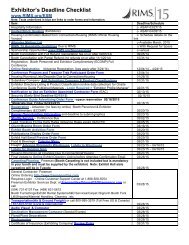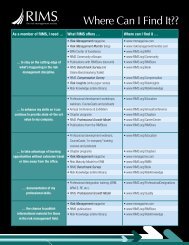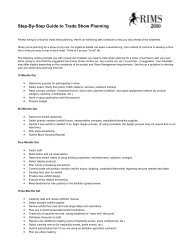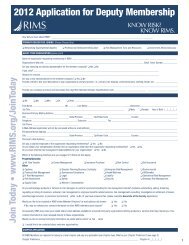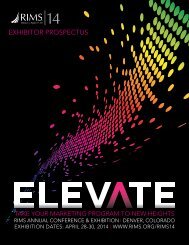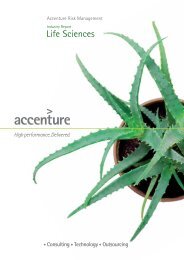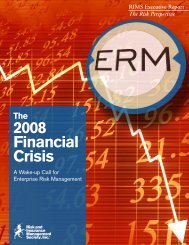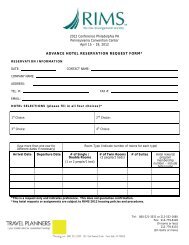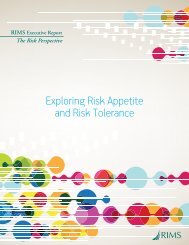StateofERMReport - RIMS
StateofERMReport - RIMS
StateofERMReport - RIMS
- No tags were found...
You also want an ePaper? Increase the reach of your titles
YUMPU automatically turns print PDFs into web optimized ePapers that Google loves.
<strong>RIMS</strong> STATE OF ERMREPORT 2008Root Cause Assessment • Maturity Model ReadinessFinancial Elements • Business ProcessesERM Plans • ResourcesAuthored and Produced by:
Table of ContentsPreface......................................................................................................................iExecutive Summary............................................................................................... 1The Business Challenge........................................................................................ 2Key Findings........................................................................................................... 3Conclusions............................................................................................................ 5Study Results for ERM Attributes....................................................................... 10Attribute 1: ERM-Based Approach ............................................................... 10Attribute 2: ERM Process Management ....................................................... 12Attribute 3: Risk Appetite Management ....................................................... 14Attribute 4: Root Cause Discipline ............................................................... 16Attribute 5: Uncovering Risks ....................................................................... 18Attribute 6: Performance Management ........................................................ 20Attribute 7: Business Resiliency and Sustainability .................................. 22
PrefaceAbout this ReportThe Risk and Insurance Management Society, Inc. (<strong>RIMS</strong>) has adopted enterprise risk management (ERM) as a core competencyand dedicates significant resources to developing tools that will support risk practitioners in establishing effective ERM programs.The <strong>RIMS</strong> ERM Development Committee was mandated by the <strong>RIMS</strong> board of directors to identify or develop training,resources and tools to help members establish, lead and sustain ERM processes within their respective organizations. One ofits early initiatives was to institute a mechanism for measuring ERM maturity so that organizations can better understand theirrisk management requirements and strategize how to reach their targeted level of risk maturity. The <strong>RIMS</strong> ERM DevelopmentCommittee selected LogicManager, a leader in ERM expertise and innovative software solutions, to develop a risk maturity modelfor ERM. LogicManager donated its intellectual property, expertise and services; and with acknowledged contributions from ERMDevelopment Committee members, the <strong>RIMS</strong> Risk Maturity Model for ERM © (RMM) was born in 2006.<strong>RIMS</strong> Risk Maturity Model for ERM is a requirements model used by executives in risk management and others charged with riskmanagement responsibilities to design sustainable ERM programs and infrastructure reflecting their organizations’ strategy andshort-, mid- and long-term business objectives. The RMM is also an educational, planning and measurement resource for boardsof directors, chief executive officers, chief financial officers, chief audit executives and consultants to evaluate the effectivenessand efficiency of an organization’s ERM program. The RMM model consists of 68 key readiness indicators that describe 25competency drivers for 7 attributes that create ERM’s value and utility in an organization. The RMM maturity ladder is organizedprogressively from “ad hoc” to “leadership” and depicts corresponding levels of risk management competency. A key part of themodel is the Risk Maturity Assessment that allows risk managers to score their risk programs online and receive a real-time report.This generates their ERM requirements customized for their organizations’ unique industries, structures, geographies, culturesand resources. This gap analysis, based on best practices, then serves as a foundation for the organization to set its priorities forfuture ERM improvements (http://www.<strong>RIMS</strong>.org/RMM).<strong>RIMS</strong> State of ERM Report 2008 is based on Risk Maturity Assessments collected over a 14-month period for 564 organizations,commencing December 2006. <strong>RIMS</strong> State of ERM Report 2008 and <strong>RIMS</strong> Risk Maturity Model for ERM are published by <strong>RIMS</strong>,produced by LogicManager and authored by Steve Minsky, with contributions by members of the <strong>RIMS</strong> ERM DevelopmentCommittee.About the Author, Steven MinskySteven Minsky is the chief executive officer and founder of LogicManager. He is the instructor of the <strong>RIMS</strong> Fellow (RF) workshoptitled “Move Your Program to the Next Level: <strong>RIMS</strong> Risk Maturity Model for ERM” and has helped more than 150 organizationsdesign their ERM charters and action plans. He is a patented author of risk and process management technologies and holdsMBA and MA degrees from the University of Pennsylvania’s Wharton School of Business and The Joseph H. Lauder Institute ofInternational Management. More about the author.About the Producer, LogicManagerLogicManager provides configurable ERM software solutions and mentoring services to accelerate risk management effectiveness.LogicManager solves the problem of how to best allocate resources by using an ERM approach to improve business performanceand reduce the cost of capital. LogicERM makes it easy for managers across the enterprise to assess their risks and opportunities,create action plans and provide evidence of their successes to stakeholders. More information is available athttp://www.logicmanager.com.About the Publisher, Risk and Insurance Management Society, Inc. (<strong>RIMS</strong>)The Risk and Insurance Management Society, Inc. is a not-for-profit membership association dedicated to advancing the practiceof risk management. Founded in 1950, <strong>RIMS</strong> represents nearly 4,000 industrial, service, nonprofit, charitable and governmententities. The Society serves more than 10,700 risk management professionals around the world. More information on <strong>RIMS</strong>programs and services, membership and access to the ERM Center of Excellence can be found online at http://www.<strong>RIMS</strong>.organd http://www.<strong>RIMS</strong>.org/ERM.About the ContributorsThe author would like to acknowledge the contributions made by the following members of <strong>RIMS</strong> in making this report valuable toERM practitioners:John Phelps, ARM, CPCUMember, <strong>RIMS</strong> Board of DirectorsBlue Cross and Blue Shield of FloridaCarol Fox, ARMChair, <strong>RIMS</strong> ERM Development CommitteeConvergys CorporationJeff Vernor, ARMVice-Chair, <strong>RIMS</strong> ERM Development CommitteeRussell InvestmentsLaurie Champion, CPCUMember, <strong>RIMS</strong> ERM Development CommitteeFormerly Coca-Cola EnterprisesSpecial thanks to Mary Roth, ARM, <strong>RIMS</strong> Executive Director<strong>RIMS</strong> State of ERM Report 2008 and <strong>RIMS</strong> Risk Maturity Model for ERM are published by <strong>RIMS</strong>, produced by LogicManager and authored by Steven Minsky, with contributions by members of the <strong>RIMS</strong>ERM Development Committee. © 2008 Risk and Insurance Management Society, Inc. (<strong>RIMS</strong>). All rights reserved.i
Executive SummaryEnterprise risk management (ERM) reduces uncertainty and, over time, improves the prospects ofsuccess for organizations that have risk management competency. More than just traditional financialand insurable hazards, ERM encompasses the entire spectrum of risk, including strategy, operations,reputation, finance, compliance and information. As organizations’ competency levels improve, so dothe odds of successfully managing all kinds of risks.Marquee companies collapse, high-profile executives step down in disgrace, and thousands ofcorporations are forced to restate financial reports. 1 The impact of these risks is preventable if resourcesare allocated while there is still time to change the outcome. Are organizations managing their riskseffectively? On the surface, they seem to be trying. Boards create risk management committees, CEOshire senior risk officers and organizations in North America alone spend nearly $30 billion annually oncompliance—$6 billion just on Sarbanes-Oxley (SOX) compliance. 2 Yet something is obviously wrong.Total losses for the global financial crisis have been estimated to reach $945 billion. 3 How can so manysmart people overestimate their risk management competency? Did they not have the right infrastructurein place? Did they not aggregate and measure risk effectively? Would these catastrophic events havebeen prevented if this same spending had been invested in an ERM approach?The current crisis is now largely seen as a failure of risk management. New government regulation formallyenforcing enterprise risk management can be expected. This will have fundamental and far-reachingramifications for the governance of organizations as well as regulators. Key members of publicly-tradedorganizations’ management are already required to discuss major risk factors, opportunities and relatedmitigation activities in filings. External auditors already are required to perform risk-based audits, whichinclude evaluating organizations’ risk management competency. The expectation is that organizationsnow will be required to go into depth on how they identify risk, set risk tolerances and provide evidenceof effectiveness. Since 2006, boards of directors in the United Kingdom have been held accountable byThe Combined Code on Corporate Governance to review and express opinions on their ERM processesand systems, based on the renowned Turnbull Report. 4 Organizations should prudently expect that similarcomprehensive requirements are imminent in the United States.From a personal perspective, our individual risk management competency predicts our credit ratings.Decision makers use our personal credit ratings for purposes far beyond traditional lending decisions,from extending insurance coverage to job offers. 5 For example, personal credit ratings are positivelycorrelated to the frequency and severity of insurance claims. 6 More than 90 percent of insurancecompanies use personal credit ratings as a key indicator of future claims performance based on individualrisk management competency. 7 If individual risk management competency is measured by personal creditratings, can the same be true of corporate credit ratings? How can boards, management, regulators,auditors and rating agencies better evaluate and measure corporate risk management competency? Howcan organizations use an ERM approach to allocate resources to better balance risk and reward?1. Treasury & Risk Magazine, Glass Lewis & Co. report, February 2008.2. AMR Research. Total compliance spending in 2007 was estimated to be $29.9 billion.3. International Monetary Fund (IMF) annual Global Financial Stability Report, April 8, 2008.4. The Combined Code on Corporate Governance, June 2006.5. “How credit scores affect insurance rates,” September 2003.6. “How Credit Scores Affect Insurance Rates,” May 2007.7. “Credit Impact,” Credit.com.<strong>RIMS</strong> State of ERM Report 2008 and <strong>RIMS</strong> Risk Maturity Model for ERM are published by <strong>RIMS</strong>, produced by LogicManager and authored by Steven Minsky, with contributions by members of the <strong>RIMS</strong>ERM Development Committee. © 2008 Risk and Insurance Management Society, Inc. (<strong>RIMS</strong>). All rights reserved.1
The Business ChallengeAlthough intuition frequently suggests to us as individuals that certain concepts have merit, we needevidence with analytical support for them to gain general acceptance and practical application in business.The relationship between risk management competency and corporate credit ratings has not been widelyaccepted for three reasons:1.2.3.absence of formalized indicators to measure risk competency;absence of infrastructure to gather information and perform analysis in a timely fashion; andabsence of a robust and consistent scoring methodology relevant to all risk cultures.These significant challenges have been surmounted by the development of the Risk and InsuranceManagement Society’s Risk Maturity Model for ERM © (RMM). The RMM codifies 68 key readinessindicators and standardizes a three-dimensional scoring methodology achieved in an online assessmenttool. 8 This tool enabled large numbers of organizations to score their organizations’ practices againststandardized criteria that could then be aggregated, analyzed and compared to each other and topublished credit ratings.As the credit crunch and other market uncertainties in the economy came to light in 2007, risk practitionersfrom 564 organizations of all types participated in an in-depth assessment of ERM. The study, based onguidelines modeled in the RMM, attempted to improve competency for managing risks, avoiding surprisesand leveraging opportunities. Using the RMM, participants compared their organizations’ ERM activitiesagainst 68 key readiness indicators identified as risk management competency drivers. They scored theirorganizations in three dimensions:• effectiveness of ERM activities;• degree of proactivity; and• coverage – pervasiveness throughout the organization.The RMM represents best-practice requirements for developing and maintaining effective ERM programs.The RMM assessment tool allows risk practitioners to score their risk programs against the same 68 keyreadiness indicators on which the <strong>RIMS</strong> State of ERM Report 2008 is based and receive a personalizedreport on their ERM program maturity level. The RMM, summarized in Table 2 (page 9), models theindicators as the key competency drivers of seven major attributes found in formalized ERM programs.8. The 68 key readiness indicators are derived from the <strong>RIMS</strong> RMM and reflect the Australian/New Zealand and COSO ERMrisk standards.<strong>RIMS</strong> State of ERM Report 2008 and <strong>RIMS</strong> Risk Maturity Model for ERM are published by <strong>RIMS</strong>, produced by LogicManager and authored by Steven Minsky, with contributions by members of the <strong>RIMS</strong>ERM Development Committee. © 2008 Risk and Insurance Management Society, Inc. (<strong>RIMS</strong>). All rights reserved.2
esponding organizations, 39 percent had formalized ERM infrastructure (With ERM). Organizations WithERM scored 90 percent better in raw RMM index scores for all risk management competency drivers thandid organizations without formalized ERM infrastructure (Without ERM).Study results also point to significant differences in maturity levels of risk management competencybetween organizations With ERM and organizations Without ERM. Ninety-three percent moreorganizations With ERM had an overall advantage in repeatable or better maturity levels for all sevenRMM attributes than organizations Without ERM. Increased competency suggests that organizations WithERM make better risk-informed decisions, which, arguably, lead to competitive advantage.Significant Shortfall for Organizations With ERMStudy results further show that organizations With ERM may have a false sense of security. They struggleto achieve a managed or better maturity level in most of the critical risk management competencies. Withinthe “Root Cause Discipline” attribute, for example, only 6 percent achieved that level for “dependenciesand consequences” and 7 percent for “classification of risk and performance indicators.” 12 Within the“Performance Management” attribute, only 6 percent achieve that level for “ERM process goals andactivities” and “communicating goals.” 13The data show a severe lack of capabilities by organizations With ERM to:••••collect risk information from all processes (especially front-line management);detect cross-departmental effects and dependencies;link risks to their respective organizations’ performance goals and objectives; and/oreffectively compare actual risk against assessed risk.(Continued) Key FindingsAll of these issues are symptoms of an organization’s failure to implement strong risk managementgovernance and infrastructure.Overall Attribute Maturity LevelsWorse scoresBetter scoresBar length shows the level ofcompetency achievementWith ERMWithout ERMAd hocInitialRepeatableManagedLeadership12. The <strong>RIMS</strong> RMM defines “Root Cause Discipline” as the degree to which risk from people, external environment,systems, processes and relationships is explored.13. The <strong>RIMS</strong> RMM defines “Performance Management” as the degree of executing vision and strategy, working fromfinancial, customer, business process and learning and growth perspectives, such as Kaplan’s balanced scorecard orsimilar approach. The “Balanced Scorecard” is a “performance planning and measurement framework” publicized byRobert S. Kaplan and David P. Norton in the early 1990s.<strong>RIMS</strong> State of ERM Report 2008 and <strong>RIMS</strong> Risk Maturity Model for ERM are published by <strong>RIMS</strong>, produced by LogicManager and authored by Steven Minsky, with contributions by members of the <strong>RIMS</strong>ERM Development Committee. © 2008 Risk and Insurance Management Society, Inc. (<strong>RIMS</strong>). All rights reserved.4
ConclusionsIn addition to the important strategic benefits associated With ERM, there are now proven direct relationshipsamong higher ERM competency, effective ERM governance and infrastructure, better business performanceand reduced short-term bottom-line costs. With the tightening of credit and better credit ratings asimportant as ever to an organization’s cost of capital, brand equity and business viability, the followingrecommendations are outlined as a result of this study:Organizations Without ERM: This study provides empirical evidence demonstrating why boards andCEOs should use the 68 key readiness indicators within the RMM as the basis to formalize their ERMinfrastructures and set goals and a timeline to formalize them.Organizations With ERM: Boards, CEOs and committees should use the RMM competency drivers asthe basis to:• assess their own maturity level against these drivers and• build ERM governance and infrastructure to achieve their targeted maturity level.It is particularly important to:• properly evaluate the degree of their organizations’ adoption and effectiveness of all RMM competencydrivers across the organization;• implement direct front-line management accountability in ERM;• consider appropriate organizational structure and reporting relationships for a senior risk managementposition;• apply a risk-based approach to prioritize existing activities to reduce internal and external costs; and• consolidate multiple assessments into one assessment that covers the needs of all functional areas.All Organizations: Rating agencies, regulators, capital markets and the courts now have reliable guidanceon how to evaluate organizations’ risk management competency. Boards, CEOs and senior risk officersresponsible for their organizations’ oversight should be committed to using the RMM to develop riskmanagement competency that is defensible when compared to the five layers of ERM infrastructurelisted below. Each layer is assessed with enterprise-wide criteria. Together, they provide one consolidatedapproach—not silos—to reduce duplication and prioritize existing and new activities.1. <strong>RIMS</strong> Risk Maturity Model for ERM—Risk managers should engage all organizational functionsto build an ERM framework for their organizations. The <strong>RIMS</strong> RMM is a statistically validatedtool that (1) helps organizations identify gaps and (2) provides a roadmap to improve riskmanagement competency, governance and infrastructure. They should go online and to assesstheir organizations’ risk management competencies at http://www.<strong>RIMS</strong>.org/RMM. They shouldthen prioritize goals and create action plans to achieve them.2. Financial Elements 14 —Risk managers should engage chief financial officers (CFOs) to integratefinancial reporting with risk management. Operational risks must be examined, given scoresand linked to financial elements if tomorrow’s surprises are to be managed in time to change theoutcome.3. Business Processes—Risk managers should engage department heads in collecting andprioritizing risks that threaten the capabilities of major processes to deliver services and productsto customers and provide accurate data for managing and reporting.4. ERM Plans—Risk managers should engage managers of processes with their teams to uncoverrisks and root cause dependencies among business areas. They should study the consequentialimpact on linked corporate objectives after considering risk priorities established by highassessment scores for financial elements and business processes.5. Resources—Risk managers should link prioritized business activities within ERM plans directlyto important related physical and informational assets to determine the impact on management’sshort-, mid- and long-term goals. Prioritizing risks to these assets enhances traditional impactanalysis with the likelihood of occurrence and controls assurance dimensions.14. “Financial Elements,” also called “accounts” or “line items,” are components of the financial statements, such as revenue,tax and cost of goods sold.<strong>RIMS</strong> State of ERM Report 2008 and <strong>RIMS</strong> Risk Maturity Model for ERM are published by <strong>RIMS</strong>, produced by LogicManager and authored by Steven Minsky, with contributions by members of the <strong>RIMS</strong>ERM Development Committee. © 2008 Risk and Insurance Management Society, Inc. (<strong>RIMS</strong>). All rights reserved.5
ERM Proven to Provide Bottom-Line BenefitsOne large insurance company has been among only 15 property and casualty insurance companiesrecognized by A.M. Best Co. for maintaining an A+ or higher financial ranking for 50 straight years. Thiscompany recognized the potential effects of an increasingly competitive business environment and movedaway from following a traditional compliance approach of simply documenting controls and managingactivities. It chose, instead, to apply the five layers of ERM infrastructure and directly involve its front-linerisk owners. The result was a dramatic reduction of internal staff hours across the board spent on existingcompliance activities and a 60 percent reduction of external audit hours. 15Risk Competency Within Attributes<strong>RIMS</strong> RMM for ERM has seven core attributes that describe thefundamental characteristics of an effective ERM process. Eachattribute contains subgroups referred to as “competency drivers.”Each competency driver contains key readiness indicators thatdrive risk management competency in ERM programs. There are25 competency drivers and 68 key readiness indicators within theseven core attributes. Possible scores for each factor range fromhigh competency to low competency. Scores for each factor areaggregated to produce scores for related attributes.Correlation of Risk Competency to Credit Ratings in Organizations With ERMOne goal of an enterprise and, thus, of ERM is to improve its sustainability and longevity. One criticalmeasure of that goal is the enterprise’s credit rating. Credit ratings are not only a short-term direct costof capital, but also, more importantly, a concrete measure of business performance. Study results havestatistically validated the correlation of an organization’s formalized ERM program, embodying all 68 keyreadiness indicators and all 25 competency drivers, and its credit rating. Further, the correlation to highercredit ratings was strongest for the competency drivers related to front-line risk participation, linkage andgovernance oversight—three foundational capabilities:1. Front-line risk participation—Front-line employees can identify risks to their processes,including the impact on specific financial elements, and then link risks with the correspondingmitigating process controls regardless of which areas throughout their organization perform thecontrols.2. Linkage—Management can evaluate each financial element, process and resource anddetermine whether underlying risks and controls are sufficiently balanced to achieve corporategoals and objectives.3. Governance oversight—ERM governance oversight can reallocate organizational resources toimprove the balance between risk and control to address risk when it exceeds the organization’srisk tolerance. In the long term, this high level of competency in reducing uncertainties in businessis the catalyst for obtaining competitive advantage through improved decision-making (forexample, sales targets, cost reductions, acquisitions or even elimination of entire business lines).When organizations lack competency in any one of the 25 competency drivers—and particularly in the 15related to these foundational capabilities—the scenario is quite different. Management may not:• realize that the organization’s risks are outside of its tolerance level;• fully understand the balance of interdependencies between risks, controls, processes andfinancial elements; or• recognize the organization’s inability to achieve, in a repeatable fashion, corporate goals andobjectives.Consequently, there may be no insight for timely intervention (business decision-making) to alter anundesirable outcome, including a negative impact on credit ratings. Organizations seeking betterperformance need to broaden and deepen their programs to mature in the competency drivers that supportfront-line risk ownership, linkage and governance oversight.15. “Audit Busters,” Treasury and Risk Magazine, February 2008.<strong>RIMS</strong> State of ERM Report 2008 and <strong>RIMS</strong> Risk Maturity Model for ERM are published by <strong>RIMS</strong>, produced by LogicManager and authored by Steven Minsky, with contributions by members of the <strong>RIMS</strong>ERM Development Committee. © 2008 Risk and Insurance Management Society, Inc. (<strong>RIMS</strong>). All rights reserved.6
Table 1 depicts median scores for the 25 competency drivers as assessed by organizations with formalizedERM programs (With ERM). All of them fall within the bottom 30th percentile of the scoring range. Onaverage, organizations With ERM had the least competency in the 15 competency drivers most stronglyconnected to front-line risk ownership, linkage and governance oversight:• Eight of the 15 underperforming competency drivers (53 percent) affect front-line riskownership.• Three (20 percent) affect linkage.• Four (27 percent) affect governance oversight.For organizations With ERM to achieve expected benefits from ERM investments, competency in frontlinerisk ownership and linkage must be achieved so that governance oversight has the necessaryinsight to better interpret and manage risks within chosen tolerance levels and properly consider complexinterdependent issues. Organizations’ failure to attain meaningful involvement of front-line process ownersin the ERM process have significantly more risk exposure than management and stakeholders realize andthan boards knowingly accepted.Risk management competency reduces:• compliance burden and cost in the short term• uncertainties for better business decisions in the long termLong-Term Benefits of Improving Risk Competency in Organizations With ERMERM enables organizations to gain efficiencies and effectiveness through a consistent and morecomprehensive approach. Investigations to determine and verify organizations’ risk managementcompetency will continue to increase.Boards, CEOs and senior risk officers must be able to defend and demonstrate their organizations’ ERMeffectiveness in order to achieve the following objectives:• Companies can avoid potential future rating agency downgrades and increased cost of capital.Standard & Poor’s and other rating agencies have incorporated ERM into their methodologies.As their expertise in evaluating ERM grows, the requirements for stronger ERM competencywill most likely become an expectation.• Companies can minimize the personal liability of board members and the risk of criminalcharges against CEOs and CFOs for failure to act reasonably in making SOX quarterlycertifications about the adequacy of internal controls over financial reporting (ICFR), includingchanges to ICFR and fraud occurrences. 16• Companies can protect the organizations’ Securities and Exchange Commission (SEC) safeharbor offered for performing risk-based management assessments of ICFR.• Board members and senior executives can receive protection against large fines and penaltiesunder Federal Sentencing Guidelines for Organizations. Penalties will be reduced by as muchas 95 percent if organizations demonstrate that they periodically assess the risk of criminalconduct, have procedures to detect and prevent violations of law and have implementedprocedures to establish an ethical culture. 17• Companies can meet regulators’ expectations of effective ERM. Regulators expectorganizations to have effective ERM for the broad spectrum of risks, representative of theirprinciples-based approach in examinations versus a rules-based approach. Public, nonprofitand government entities are required by state and federal laws to perform risk-basedmanagement assessments.• Board members and senior executives can develop scoping for control and fraud assessmentactivities to maximize benefits (for example, reduce fees and internal efforts) from thetop-down, risk-based mandate of Public Company Accounting Oversight Board (PCAOB)Auditing Standard 5.16. Public Company Accounting Oversight Board (PCAOB) Auditing Standard 5, July 2007.17. An Overview of the Organizational Guidelines, United States Sentencing Commission.<strong>RIMS</strong> State of ERM Report 2008 and <strong>RIMS</strong> Risk Maturity Model for ERM are published by <strong>RIMS</strong>, produced by LogicManager and authored by Steven Minsky, with contributions by members of the <strong>RIMS</strong>ERM Development Committee. © 2008 Risk and Insurance Management Society, Inc. (<strong>RIMS</strong>). All rights reserved.7
Table 1: Competency Driver PerformanceOrganizations With ERM3Adverse events as opportunitiesCommunicating goalsDependencies and consequencesIndicator classificationsERM process oversightFront-line and support process owner participationERM process goals and activitiesResiliency and operational planningRisk culture, accountability and communicationRoot cause considerationRisk management reportingRisk-reward tradeoffsAnalysis-based planningRisk ownership by business areasBusiness process definition and risk ownershipExecutive support for ERMFollow-up reportingFar-sighted risk management visionRisk portfolio viewUnderstanding consequencesFormalized risk indicators and measuresRisk and opportunity information collectionERM information and planningERM process stepsRepeatability and scalabilityFront-line employee ownership Linkage Governance oversight Factors with above average performanceThis chart depicts the competency drivers covered in this study. Drivers with below the line scores indicate areas where participants, on average, have made the leastprogress. Each competency driver below the line has been colored coded to associate it with a foundational capability as described above.2.521.510.50-0.5-1-1.5<strong>RIMS</strong> State of ERM Report 2008 and <strong>RIMS</strong> Risk Maturity Model for ERM are published by <strong>RIMS</strong>, produced by LogicManager and authored by Steven Minsky, with contributions by members of the <strong>RIMS</strong>ERM Development Committee. © 2008 Risk and Insurance Management Society, Inc. (<strong>RIMS</strong>). All rights reserved.8
Table 2: <strong>RIMS</strong> Risk Maturity Model for ERM Summary 18Attributes1Adoption ofERM-basedapproachMaturity LevelsLevel 5LeadershipLevel 4ManagedLevel 3RepeatableLevel 2InitialCompetency Drivers: Degree of• Executive support for ERM• Business process definition and risk ownership• Far-sighted risk management vision• Front line and support process owner participationLevel 1Ad hoc2ERM processmanagement3Risk appetitemanagementCompetency Drivers: Degree of• Repeatability and scalability• ERM process oversight• ERM process steps• Risk culture, accountability and communication• Risk management reportingCompetency Drivers: Degree of• Risk portfolio view• Risk-reward tradeoffs4Root causedisciplineCompetency Drivers: Degree of• Dependencies and consequences• Indicator classifications• Risk and opportunity information collection• Root cause consideration5Uncovering risksCompetency Drivers: Degree of• Formalized risk indicators and measures• Adverse events as opportunities• Follow-up reporting• Risk ownership by business areas6PerformancemanagementCompetency Drivers: Degree of• ERM information and planning• Communicating goals• ERM process goals and activities7Businessresiliency andsustainabilityCompetency Drivers: Degree of• Analysis-based planning• Resiliency and operational planning• Understanding consequences18. See <strong>RIMS</strong> Risk Maturity Model for ERM.<strong>RIMS</strong> State of ERM Report 2008 and <strong>RIMS</strong> Risk Maturity Model for ERM are published by <strong>RIMS</strong>, produced by LogicManager and authored by Steven Minsky, with contributions by members of the <strong>RIMS</strong>ERM Development Committee. © 2008 Risk and Insurance Management Society, Inc. (<strong>RIMS</strong>). All rights reserved.9
Study Results for ERM AttributesAttribute 1: ERM-Based ApproachAttribute 1 denotes the degree of executive support for an ERM-based approach within the corporateculture. Risk management activities within organizations committed to an ERM-based approach go beyondregulatory compliance. Activities cut across all processes, functions, business lines, roles and geographiesand include integrating, communicating and coordinating with front-line and support areas, includinginternal audit, information technology (IT), compliance, corporate security, business continuity and riskmanagement.What “Well-Managed” Looks LikeAn organization with a mature risk culture analyzes and reports on risk management activities using asystematic approach. Executive sponsorship is strong, and the tone from the top has embedded an ERMbasedapproach into the corporate culture. Boards of directors, senior management and senior risk officerscommunicate the importance of risk management in daily decision-making to each business function. Allareas use risk-based best practices.Executive management believes it receives the behavior for which it pays. Risk management competencyis a prerequisite for promotion to all leadership positions, and risk-based goals are required for pay-forperformancebonuses.Assessment ResultsThe following charts depict assessment results for Attribute 1: ERM-Based Approach. Significantdifferences were found between organizations with formalized ERM programs (With ERM) andorganizations without formalized ERM programs (Without ERM) (Chart 1.1). Organizations With ERMclearly scored better than organizations Without ERM. Nevertheless, all organizations scored low acrossthe range in all competency drivers underlying Attribute 1 (Chart 1.2).Of particular concern is the lack of involvement in risk management activities by operations and supportareas, which is equivalent to trying to manage the effects of risks without understanding the causes.The degree to which risk assessments are consistently conducted in all business areas and to whichrisk management issues are clearly understood at all levels is one of the highest competency driverscorrelated with higher credit ratings. Until all areas use risk-based best practices in daily decision-making,attaining a high degree of risk competency in the other attributes is unlikely. Organizations cannot derivethe full spectrum of benefits from effective ERM until targeted competency is improved for all drivers withinAttribute 1.<strong>RIMS</strong> State of ERM Report 2008 and <strong>RIMS</strong> Risk Maturity Model for ERM are published by <strong>RIMS</strong>, produced by LogicManager and authored by Steven Minsky, with contributions by members ofthe <strong>RIMS</strong> ERM Development Committee. © 2008 Risk and Insurance Management Society, Inc. (<strong>RIMS</strong>). All rights reserved. 10
Attribute 1: Overall Maturity LevelsAdoption of ERM-Based ApproachWorse scoresBetter scoresBar length shows percentage oforganizations achieving that maturity levelWith ERMWithout ERMChart 1.1Eighty-one percent more participating organizations With ERM achieve a repeatable or better maturitylevel for Attribute 1 than organizations Without ERM. Organizations cannot derive the full spectrum ofbenefits from effective ERM until targeted competency is improved for all drivers within Attribute 1.Attribute 1: Average Competency Driver Maturity LevelsAdoption of ERM-Based ApproachWorse scoresBetter scoresBar length shows the level ofcompetency achievementWith ERMWithout ERMAd hocInitialRepeatableManagedLeadershipChart 1.2Both organizational groups have significant gaps between their levels and best practice, but the With ERMgroup scored materially better than the Without ERM group. The degree to which risk assessments areconsistently conducted in all business areas and to which risk management issues are clearly understoodat all levels is one of the highest competency drivers correlated with higher credit ratings.<strong>RIMS</strong> State of ERM Report 2008 and <strong>RIMS</strong> Risk Maturity Model for ERM are published by <strong>RIMS</strong>, produced by LogicManager and authored by Steven Minsky, with contributions by members ofthe <strong>RIMS</strong> ERM Development Committee. © 2008 Risk and Insurance Management Society, Inc. (<strong>RIMS</strong>). All rights reserved. 11
Attribute 2: ERM Process ManagementAttribute 2 denotes the degree of incorporation of repeatable and scalable risk management processesinto all business and resource/support units, bolstered by qualitative and quantitative measurements,analyses, tools and models; robust reporting on risk management activities; and clarity of oversight,including roles and responsibilities. The ERM process is defined as a sequential series of steps thatsupport the reduction of uncertainty and promote the exploitation of opportunities. 19What “Well-Managed” Looks LikeIn all units, roles and responsibilities are process-driven. Teams collaborate across support and fieldpositions. Risk and performance assumptions made for quantitative and qualitative measurements areroutinely revisited and updated. Organizations use the ERM process for sequential steps to improvedecision-making and performance. Accountability for risk management is woven into all units, processes,support functions, business lines and geographies as the preferred way to achieve goals.Committed organizations create ERM plans to define the context in which the rest of the process will takeplace. The ERM process within an ERM plan requires the following steps:1.2.3.4.5.identification of where, when, why and how business model, market, events, operations andother elements associated with business changes, issues and others—whether known orunderreported—might prevent, degrade or support goals;assessment of perceived risk and opportunity through consistent, objective and pervasiveevaluation criteria of impact, likelihood and effectiveness of controls to quantify the risk level;evaluation of risk tolerance to determine acceptable risk and opportunity levels and considerationof the balance between potential benefits and drawbacks (see Attribute 3: Risk AppetiteManagement);creation of value by mitigating and optimizing risk and leveraging opportunity activities to reduceuncertainty, increasing potential benefits and reducing potential costs; andmonitoring the timeliness and effectiveness of activities by risk owners and gauging the programto ensure that changing circumstances are recognized and that appropriate alterations to prioritiesare made, rather than allowing problems to escalate – thus allowing focus on shifting priorities andon value creation and reducing overspending on controls.Assessment ResultsThe following charts depict assessment results for Attribute 2: ERM Process Management. Significantdifferences were found between organizations with formalized ERM programs (With ERM) andorganizations without formalized ERM programs (Without ERM). Organizations With ERM scored betterthan organizations Without ERM in all competency drivers underlying Attribute 2. However, competency in“risk management reporting” is a major issue for both groups.One may conclude that the lack of dynamic, available and shared data is a cause for organizations’inability to report effectively and could hinder risk analysis going forward. A formalized ERM governancestructure determines what data are to be collected, how to name and classify the data and where to createrelationships between the data. As ERM matures as a discipline, weakness in this factor will affect lateadopters of effective ERM infrastructure the most.The lack of repeatability and scalability in processes and systems prevents the ability to compare dataover time, such as trending analyses or risk history required to establish meaningful risk tolerances, whichthe late adopters will be unable to overcome quickly. See the Root Cause Discipline and Risk AppetiteManagement sections of the RMM.19. See the definition section of <strong>RIMS</strong> Risk Maturity Model for ERM for more detail on ERM Process.<strong>RIMS</strong> State of ERM Report 2008 and <strong>RIMS</strong> Risk Maturity Model for ERM are published by <strong>RIMS</strong>, produced by LogicManager and authored by Steven Minsky, with contributions by members ofthe <strong>RIMS</strong> ERM Development Committee. © 2008 Risk and Insurance Management Society, Inc. (<strong>RIMS</strong>). All rights reserved. 12
Attribute 2: Overall Maturity LevelsERM Process ManagementWorse scoresBetter scoresBar length shows percentage oforganizations achieving that maturity levelWith ERMWithout ERMChart 2.1Organizations with formalized ERM programs (With ERM) had 151 percent more participants achieve arepeatable or better maturity level for Attribute 2 than did organizations without formalized ERM (WithoutERM). The lack of repeatability and scalability in processes and systems prevents the ability to comparedata over time, such as trending analyses or risk history required to establish meaningful risk tolerances,which the late adopters will be unable to overcome quickly.Attribute 2: Average Competency Driver Maturity LevelsERM Process ManagementWorse scoresBetter scoresBar length shows the level ofcompetency achievementWith ERMWithout ERMAd hocInitialRepeatableManagedLeadershipChart 2.2This attribute is one area in which organizations With ERM have made some progress and is the areashowing the least progress in organizations Without ERM. One may conclude that the lack of dynamic,available and shared data is a cause for organizations’ inability to report effectively and could hinder riskanalysis going forward.<strong>RIMS</strong> State of ERM Report 2008 and <strong>RIMS</strong> Risk Maturity Model for ERM are published by <strong>RIMS</strong>, produced by LogicManager and authored by Steven Minsky, with contributions by members ofthe <strong>RIMS</strong> ERM Development Committee. © 2008 Risk and Insurance Management Society, Inc. (<strong>RIMS</strong>). All rights reserved. 13
Attribute 3: Risk Appetite ManagementAttribute 3 denotes the degree of understanding and accountability throughout organizations for:• defining acceptable boundaries for risk types;• calculating and articulating approved variations for risks outside of boundaries (risk tolerance);• developing views of risk impact, likelihood and assurance from different perspectives such asoperations and financial reporting (risk portfolio views);• considering the benefits of risk and reward tradeoff scenarios in daily management of businessand resource/support units; and• attacking gaps between perceived and actual risks.What “Well-Managed” Looks LikeOrganizations achieving a managed maturity level for Risk Appetite Management generally employenterprise risk committees or councils. Such councils should suit the entity’s structure and culture. Theymay have different levels of authority in various organizations, but should be aligned with the top governingbody. Ultimately, such councils should have direct reporting into C-level management. Considering theorganizations’ short- and mid-term objectives, as well as their longer-term strategic plans and goals (riskappetite), these councils may be authorized to define or recommend acceptable boundaries for risk typesto senior management and/or the board. Typical risk appetite, boundary-defining decisions may include,but are not limited to, taking more risk to gain market share or establishing a conservative hold position toprotect the brand. Risk tolerances are expressed for each risk factor assessed by front-line risk owners inany process throughout the organization.Examples of risk competency drivers may include recordkeeping-related fraud or customer management.Established risk tolerances are revisited during planning and execution activities at all levels, andevidence can be provided of challenges and re-evaluation of risk tolerance that take place during the ERMprocess. Boards and senior leadership, supported by enterprise risk councils, define organizational risktolerances that all business and resource/support units recognize in their daily risk management activities.A transparent mechanism compares and reports units’ actual assessed risk to the organization’s definedrisk tolerances. Units have risk plans that either defend variations or incorporate mitigating activities toreduce variations. Senior leadership (perhaps through its designated risk councils) and units determinepriorities and allocate resources in the best interest of the organization, which aligns units’ tactical planswith organizational goals.Assessment ResultsThe following charts depict assessment results for Attribute 3: Risk Appetite Management. Significantdifferences continue to exist between organizations with formalized ERM programs (With ERM) andorganizations without formalized ERM programs (Without ERM). Organizations With ERM, however,scored lowest on this attribute in comparison to their scores on all other attributes.Many organizations have or are creating board- and executive-level enterprise risk committees in orderto provide better oversight for their risk management programs. Low scores on this attribute indicatethe lack of direct involvement by front-line risk owners in the ERM process and the capability for riskassessment information to be aggregated and analyzed and dependencies addressed (see Attribute1). As organizations and stakeholders become more knowledgeable and implement effective ERMinfrastructures, scores could improve for competency drivers within this attribute.<strong>RIMS</strong> State of ERM Report 2008 and <strong>RIMS</strong> Risk Maturity Model for ERM are published by <strong>RIMS</strong>, produced by LogicManager and authored by Steven Minsky, with contributions by members ofthe <strong>RIMS</strong> ERM Development Committee. © 2008 Risk and Insurance Management Society, Inc. (<strong>RIMS</strong>). All rights reserved. 14
Attribute 3: Overall Maturity LevelsRisk Appetite ManagementWorse scoresBetter scoresBar length shows percentage oforganizations achieving that maturity levelWith ERMWithout ERMChart 3.1Organizations with formalized ERM Programs (With ERM) had 77 percent more participants achieve arepeatable or better maturity level than did organizations Without ERM. As organizations and stakeholdersbecome more knowledgeable and implement effective ERM infrastructures, scores could improve forcompetency drivers within this attribute.Attribute 3: Average Competency Driver Maturity LevelsRisk Appetite ManagementWorse scoresBetter scoresBar length shows the level ofcompetency achievementWith ERMWithout ERMAd hocInitialRepeatableManagedLeadershipChart 3.2Organizations With ERM assessed their competency lowest in Risk Appetite Management as comparedto the other six attributes. Low scores on this attribute indicate the lack of direct involvement by front-linerisk owners in the ERM process and the capability for risk assessment information to be aggregated andanalyzed and dependencies addressed.<strong>RIMS</strong> State of ERM Report 2008 and <strong>RIMS</strong> Risk Maturity Model for ERM are published by <strong>RIMS</strong>, produced by LogicManager and authored by Steven Minsky, with contributions by members ofthe <strong>RIMS</strong> ERM Development Committee. © 2008 Risk and Insurance Management Society, Inc. (<strong>RIMS</strong>). All rights reserved. 15
Attribute 4: Root Cause DisciplineAttribute 4 denotes the degree of discipline applied to measuring a problem’s root cause by:• determining the sources or causes of identified risks and opportunities;• understanding the sources and impact of risks on other areas within an organization;• identifying trends in root cause categories; and• collecting information and measurements related to the effectiveness of controls withconsideration given to sources of identified risks.What “Well-Managed” Looks LikeOrganizations achieving a managed maturity level for this attribute explore risks caused by sources thatare clearly mutually exclusive. Clearly mutually exclusive sources have three major benefits:1.2.3.They avoid redundancy of identified risks.Risk identification is easier for risk owners.Mitigation and/or optimizing activities are likely to be effective if applied at the source of a risk.One example of source categories is external, people, processes, relationships and systems. 20Organizations focus on sources and causes in all risk management activities. “Post mortems” areperformed to deconstruct past events (either their own or others’) into root cause categories to betterprepare for future events. The frequency, impact and likelihood of identified risks and their sources areanalyzed and evaluated as a routine part of risk management activities. The discipline of reviewing all risksources and causes is promoted to provide a comprehensive view of risk and opportunity. This representsproactive risk management, rather than simple problem management.Assessment ResultsThe following charts depict assessment results for Attribute 4: Root Cause Discipline. Most differencescontinue to be between organizations with formalized ERM programs (With ERM) and organizationswithout formalized ERM programs (Without ERM). Organizations With ERM scored about the same acrossthe board on all of the underlying competency drivers within the Attribute; however, scores were low acrossthe range in all competency drivers underlying Attribute 4.Organizations that reflect a low level of competency in this attribute are likely to be relatively ineffectiveand inefficient in analyzing problems and applying solutions, identifying risks and designing mitigatingactivities and discovering critical trends that can prevent negative consequences and leverageopportunities.20. See Root Cause Discipline in <strong>RIMS</strong> Risk Maturity Model for ERM.<strong>RIMS</strong> State of ERM Report 2008 and <strong>RIMS</strong> Risk Maturity Model for ERM are published by <strong>RIMS</strong>, produced by LogicManager and authored by Steven Minsky, with contributions by members ofthe <strong>RIMS</strong> ERM Development Committee. © 2008 Risk and Insurance Management Society, Inc. (<strong>RIMS</strong>). All rights reserved. 16
Attribute 4: Overall Maturity LevelsRoot Cause DisciplineWorse scoresBetter scoresBar length shows percentage oforganizations achieving that maturity levelWith ERMWithout ERMChart 4.1Organizations with formalized ERM programs (With ERM) had 78 percent more participants achieve arepeatable or better maturity level than did organizations without formalized ERM programs (WithoutERM). Organizations without a formalized taxonomy will have difficulty identifying risks, designingmitigating activities and discovering critical trends that can prevent negative consequences and leverageopportunities.Attribute 4: Average Competency Driver Maturity LevelsRoot Cause DisciplineWorse scoresBetter scoresBar length shows the level ofcompetency achievementWith ERMWithout ERMAd hocInitialRepeatableManagedLeadershipChart 4.2Organizations with formalized ERM programs (With ERM) were at an early initial maturity level in thisattribute. Organizing data into root cause categories is a requirement to achieve a repeatable maturitylevel.<strong>RIMS</strong> State of ERM Report 2008 and <strong>RIMS</strong> Risk Maturity Model for ERM are published by <strong>RIMS</strong>, produced by LogicManager and authored by Steven Minsky, with contributions by members ofthe <strong>RIMS</strong> ERM Development Committee. © 2008 Risk and Insurance Management Society, Inc. (<strong>RIMS</strong>). All rights reserved. 17
Attribute 5: Uncovering RisksAttribute 5 denotes the degree of quality and coverage (penetration) throughout organizations for:• documenting risks and opportunities in risk assessment activities;• collecting knowledge from employee expertise, databases and other electronic files (suchas Microsoft Word, Excel, and so on) to uncover dependencies and correlation across theenterprise;• using adverse events to create opportunities;• establishing risk ownership by business and resource/support units;• formalizing risk indicators and measurements; and• follow-up reporting on risk management activities from varying perspectives.What “Well-Managed” Looks LikeOrganizations that achieve a managed maturity level for Attribute 5 have routine, often real-time reportingmechanisms that bring risks and opportunities to senior management’s attention for timely considerationand deployment of resources. Organizations’ ERM infrastructures actively engage all front-line employeesin identifying emerging risks and opportunities, and then assess the risks to determine the appropriatetreatment approaches and activities to address the risks in the context of risk and reward tradeoffs.Organizations’ enterprise risk councils regularly review critical risk indicators with units. Councils add andreview risk indicators that must be assessed and mitigated by the units in order to achieve organizationalgoals and objectives. Councils also review and approve standardized criteria used by units to score riskor performance impact, likelihood and control effectiveness. Standardized scoring criteria are appliedconsistently throughout organizations so that units’ assessments may be evaluated comparatively.Comparisons of units’ assessments are used to prioritize resource allocations and follow-up reporting.Process owners regularly review and recommend risk indicators that best measure their areas’ risks.Assessment ResultsThe following charts depict assessment results for Attribute 5: Uncovering Risks. Meaningful differencesexist between organizations with formalized ERM programs (With ERM) and organizations withoutformalized ERM programs (Without ERM).Uncovering Risks is the most basic and straightforward attribute in the RMM. The degree to which frontlinerisk owners identify risks specific to their business areas and processes to create meaningful contextfor their risk-mitigation activities is one of the competencies found among those with higher credit ratings.Organizations achieving higher levels of competency in these drivers are better protected from incurringcatastrophic losses, seeing their CEOs step down in disgrace or experiencing financial restatements.Organizations’ boards and executive management may put too much of their focus on just the top 10or top 20 risks and not enough on identifying risks by each front-line owner and then aggregating theresults. Considering the short-term, bottom-line impact and the long-term business sustainability impacts,organizations need to invest more heavily in their ERM governance and infrastructure.<strong>RIMS</strong> State of ERM Report 2008 and <strong>RIMS</strong> Risk Maturity Model for ERM are published by <strong>RIMS</strong>, produced by LogicManager and authored by Steven Minsky, with contributions by members ofthe <strong>RIMS</strong> ERM Development Committee. © 2008 Risk and Insurance Management Society, Inc. (<strong>RIMS</strong>). All rights reserved. 18
Attribute 5: Overall Maturity LevelsUncovering RisksWorse scoresBetter scoresBar length shows percentage oforganizations achieving that maturity levelWith ERMWithout ERMChart 5.1Organizations with formalized ERM programs (With ERM) had 110 percent more participants achieve arepeatable or better maturity level for Attribute 5 than did organizations without formalized ERM (WithoutERM). Organizations’ boards and executive management need to focus more on identifying risks by eachfront-line owner and then aggregating the results.Attribute 5: Average Competency Driver Maturity LevelsUncovering RisksWorse scoresBetter scoresBar length shows the level ofcompetency achievementWith ERMWithout ERMAd hocInitialRepeatableManagedLeadershipChart 5.2Organizations With ERM fall short in all underlying competency drivers, which are central to managingrisk while there is still time to change the outcome. The degree to which front-line risk owners identify risksspecific to their business areas is one of the competencies found among those with higher credit ratings.<strong>RIMS</strong> State of ERM Report 2008 and <strong>RIMS</strong> Risk Maturity Model for ERM are published by <strong>RIMS</strong>, produced by LogicManager and authored by Steven Minsky, with contributions by members ofthe <strong>RIMS</strong> ERM Development Committee. © 2008 Risk and Insurance Management Society, Inc. (<strong>RIMS</strong>). All rights reserved. 19
Attribute 6: Performance ManagementAttribute 6 denotes the degree to which organizations are able to execute on vision and strategy in tandemwith risk management activities by:• clearly articulating and communicating organizational goals to all business and resource/support units;• ensuring that goals and objectives are specific, measureable, attainable, realistic andtrackable (SMART);• mandating that deviations from plans or expectations are measured and reported againstgoals and objectives; and• aligning ERM process goals and activities with organizational goals and objectives.What “Well-Managed” Looks LikeOrganizations that have achieved a managed maturity level for Attribute 6 believe their ERM process isan important element in strategy and planning activities at all levels within their organizations. The mantra”if you can’t measure it, you can’t manage it” is deeply embedded in their risk culture. Goals are alwaysSMART.To ensure a proper mix of short-, mid- and long-term goals that contribute to ongoing health and longevity,organizations work from a performance-management framework, such as Kaplan’s balanced scorecard,which addresses financial, customer, business process and learning-and-growth perspectives 21 .Clear communication of organizational goals to units is critical for overall alignment and effective tacticalexecution of activity-level plans and use of resources. Reports must cover deviations from plans orexpectations. Leading organizations structure pay-for-performance goals to include how well individualsmanage risks that threaten their achievement of their objectives.Assessment ResultsThe following charts depict assessment results for Attribute 6: Performance Management. Significantdifferences persist between organizations with formalized ERM programs (With ERM) and organizationswithout formalized ERM programs (Without ERM). Organizations With ERM scored about the same acrossthe board for all underlying competency drivers within the attribute; however, these scores are among thelowest of any of the attributes.To achieve improvements in underlying competency drivers within this attribute, organizations can developor restructure pay-for-performance bonuses to compensate individuals not only for achieving specificperformance goals, but also for how effectively they manage related risks. Two key readiness indicatorsstrongly correlated to higher credit ratings are “ERM is woven into strategy and planning” and “Riskmanagement competency is part of career development for all levels.”21. See footnote 13.<strong>RIMS</strong> State of ERM Report 2008 and <strong>RIMS</strong> Risk Maturity Model for ERM are published by <strong>RIMS</strong>, produced by LogicManager and authored by Steven Minsky, with contributions by members ofthe <strong>RIMS</strong> ERM Development Committee. © 2008 Risk and Insurance Management Society, Inc. (<strong>RIMS</strong>). All rights reserved. 20
Attribute 6: Overall Maturity LevelsPerformance ManagementWorse scoresBetter scoresBar length shows percentage oforganizations achieving that maturity levelWith ERMWithout ERMChart 6.1Organizations with formalized ERM programs (With ERM) had 92 percent more participants achieve arepeatable or better maturity level than did organizations without formalized ERM programs (WithoutERM). Organizations need to develop or restructure pay-for-performance bonuses to compensateindividuals not only for achieving specific performance goals, but also for how effectively they managerelated risks to achieve improvements in underlying competency drivers within this attribute.Attribute 6: Average Competency Driver Maturity LevelsPerformance ManagementWorse scoresBetter scoresBar length shows the level ofcompetency achievementWith ERMWithout ERMAd hocRepeatableManagedLeadershipChart 6.2Scores indicate that neither organizations With ERM nor organizations Without ERM have achievedthe necessary competency to meld performance and risk management activities. The scores for thecompetency driver “ERM information and planning” with its two key readiness indicators “ERM is woveninto strategy and planning” and “Risk management competency is part of career development for all levels”are strongly correlated to higher credit ratings.Initial<strong>RIMS</strong> State of ERM Report 2008 and <strong>RIMS</strong> Risk Maturity Model for ERM are published by <strong>RIMS</strong>, produced by LogicManager and authored by Steven Minsky, with contributions by members ofthe <strong>RIMS</strong> ERM Development Committee. © 2008 Risk and Insurance Management Society, Inc. (<strong>RIMS</strong>). All rights reserved. 21
Attribute 7: Business Resiliency and SustainabilityAttribute 7 denotes the extent to which an organization integrates business resiliency and sustainabilityaspects for its operational planning into its ERM process by:• evaluating how planning by business and resource/support units support resiliency and value;• ensuring that units acknowledge their responsibility for resiliency in their planning activities;• balancing short-term deliverables with longer-term value;• documenting logistics, security, resources and organization of response procedures; and• relying on analysis-based planning (for example, stress-testing investment portfolios).“Resiliency” is defined as an organization’s ability to recover quickly from setbacks.“Sustainability” is defined as an organization’s ability to maintain something of value (for example, deliveryof services and products to customers).What “Well-Managed” Looks LikeOrganizations achieving a managed maturity level for Attribute 7 frame all issues within the contextof continuity of services to their respective stakeholders. The particulars of Business Resiliency andSustainability are defined differently by each organization and at different levels within the organization,based on their respective priorities. Business activities are linked to resources in order to understanddependencies. Activities and resources are prioritized based on business-driven impact analysis.Companies operate in a dynamic and evolving environment; therefore, long-term sustainability requirescontinuous adaptation in order to respond to changing business conditions and competitive priorities.Areas for which leading organizations commonly address resiliency and sustainability include IT recovery,vendor and distribution channel dependencies, supply-chain disruptions, unexpected market changes,cash-flow volatility, business liquidity and so on. Best practices suggest that well-managed organizationsembed Business Resiliency and Sustainability in existing business analysis and planning processes.Assessment ResultsThe following charts depict assessment results for Attribute 7: Business Resiliency and Sustainability.Substantial differences are found between organizations with formalized ERM programs (With ERM)and organizations without formalized ERM programs (Without ERM). Organizations With ERM seemto understand the consequences of inadequate organizational resiliency and sustainability much betterthan organizations Without ERM. Both groups’ scores indicate they have an opportunity to mature theirrespective practices related to the competency drivers within this attribute.Low scores may indicate that resiliency planning has been performed in silos, by outside consultantsor by using a checklist approach. The factor of resiliency and operational planning, which includes thecompetency driver of “Logistics, security, resources and organization of response procedures are welldocumented,” seems to have the highest competency of all factors, but also has the lowest correlation withbetter credit ratings. Documenting alone, otherwise known as a compliance approach, without prioritizingactivities according to the risk associated with the related business activities, is not a value-addingprocess.Low scores across the range for both groups indicate more needs to be done to enable risk assessmentsby front-line risk owners to determine the need for business-continuity analyses and planning.Organizations will continue to struggle with a constantly changing environment and increasinglycompetitive business environment if they are not able to easily link their business activities to theunderlying physical and informational assets to determine priorities. The opportunity to utilize ERMprocesses to build a more sustainable and resilient organization may be found with more focus on the riskwithin the business activities beyond traditional impact analysis.<strong>RIMS</strong> State of ERM Report 2008 and <strong>RIMS</strong> Risk Maturity Model for ERM are published by <strong>RIMS</strong>, produced by LogicManager and authored by Steven Minsky, with contributions by members ofthe <strong>RIMS</strong> ERM Development Committee. © 2008 Risk and Insurance Management Society, Inc. (<strong>RIMS</strong>). All rights reserved. 22
Worse scoresAttribute 7: Overall Maturity LevelsBusiness Resiliency and SustainabilityBetter scoresBar length shows percentage oforganizations achieving that maturity levelWith ERMWithout ERMChart 7.1Organizations with formalized ERM programs (With ERM) had 80 percent more participants achieve arepeatable or better maturity level than did organizations without formalized ERM programs (WithoutERM). Organizations achieving high maturity levels for this attribute are less likely to indicate thatresiliency planning has been performed in silos, by outside consultants or by using a checklist approach.Attribute 7: Average Competency Driver Maturity LevelsBusiness Resiliency and SustainabilityWorse scoresBetter scoresBar length shows the level ofcompetency achievementWith ERMWithout ERMAd hocInitialRepeatableManagedLeadershipChart 7.2While neither group’s score indicates an acceptable grasp of competency drivers within the Attribute,organizations With ERM seem to understand the consequences much better than do those Without ERM.The large gap in competency drivers indicates that organizations need to move beyond the complianceapproach of just documenting procedures and managing activities to instead prioritizing activitiesaccording to the risk associated with the related business activities.<strong>RIMS</strong> State of ERM Report 2008 and <strong>RIMS</strong> Risk Maturity Model for ERM are published by <strong>RIMS</strong>, produced by LogicManager and authored by Steven Minsky, with contributions by members ofthe <strong>RIMS</strong> ERM Development Committee. © 2008 Risk and Insurance Management Society, Inc. (<strong>RIMS</strong>). All rights reserved. 23
Risk practitioners from 564 organizations participated in an in-depth assessment study on ERM. Using the<strong>RIMS</strong> Risk Maturity Model for ERM © (RMM), participants compared their organizations’ ERM activities to25 competency drivers representing 68 key readiness indicators believed to be necessary drivers for aneffective, efficient ERM program. They scored their organizations from three perspectives:• effectiveness of ERM activities;• level or degree of proactivity; and• extent of overall organizational involvement in ERM (coverage).Each perspective was scored on a scale of 1 to 10. The three perspectives were multiplied together tocreate a raw index score for each factor.Based on participants’ responses to the question of whether their organizations had formalized theirERM infrastructures, participants were divided into two populations: “With ERM” and “Without ERM.” Thisquestion was asked of participants after they had completed their surveys to ensure that it would not biastheir scores. The breakdown was:• With ERM: 39%• Without ERM: 61%Appendix A: MethodologyValidating Significance of Results for the Two PopulationsA “two-sample z-test” was performed on each of the two populations for each of the 25 competencydrivers. This is a method of testing a statistical hypothesis so that statistical decisions can be made fromand about experimental data. This statistical test enabled an examination of whether results for the WithERM population and the Without ERM population were statistically meaningful and significantly differentabove a 95 percent confidence level.The conclusion is that responses from companies in the two populations are significantly different on astatistical level.Translating Raw Scores to a Maturity Level Model ScaleTo translate raw scores to a maturity level model scale, a formula was needed to represent the data setsWith ERM and Without ERM. Seven types of regressions were explored including linear regression,nonlinear regression, logistic regression and logistic nonlinear regression to determine a formula thatbest fits the data. The resulting regression formula chosen had a 97.97 percent confidence of accuratelyrepresenting the data sets for the two populations. The formula was applied to the raw index scores totranslate both the With ERM and Without ERM populations’ raw index scores to maturity level scores.<strong>RIMS</strong> State of ERM Report 2008 and the <strong>RIMS</strong> Risk Maturity Model for ERM © (RMM) are published by<strong>RIMS</strong> and produced and developed by LogicManager in collaboration with the <strong>RIMS</strong> ERM DevelopmentCommittee. Data are based on results gathered from participants’ assessments of their ERMinfrastructure, which is based on guidelines modeled in the <strong>RIMS</strong> RMM.<strong>RIMS</strong> State of ERM Report 2008 and <strong>RIMS</strong> Risk Maturity Model for ERM are published by <strong>RIMS</strong>, produced by LogicManager and authored by Steven Minsky, with contributions by members ofthe <strong>RIMS</strong> ERM Development Committee. © 2008 Risk and Insurance Management Society, Inc. (<strong>RIMS</strong>). All rights reserved. 24
Appendix B: Participation BreakdownGeography Without ERM With ERMUnited States 81% 67%Canada 9% 10%Europe 3% 4%Other 7% 19%Ownership Structure Without ERM With ERMPrivate 64% 53%Public 36% 47%Company Revenues Without ERM With ERM$5 billion and more 14% 20%$1 billion to $5 billion 24% 29%$500 million to $1 billion 10% 7%$50 million to $500 million 28% 24%Under $50 million 24% 20%Industry Without ERM With ERMConstruction 5% 1%Education 8% 5%Financial 20% 38%Government 10% 5%Healthcare 7% 3%Manufacturing 12% 14%Other Services 12% 5%Retail 9% 3%Services 6% 7%Technologies 1% 3%Transportation 4% 5%Utilities 6% 11%<strong>RIMS</strong> State of ERM Report 2008 and <strong>RIMS</strong> Risk Maturity Model for ERM are published by <strong>RIMS</strong>, produced by LogicManager and authored by Steven Minsky, with contributions by members ofthe <strong>RIMS</strong> ERM Development Committee. © 2008 Risk and Insurance Management Society, Inc. (<strong>RIMS</strong>). All rights reserved. 25



